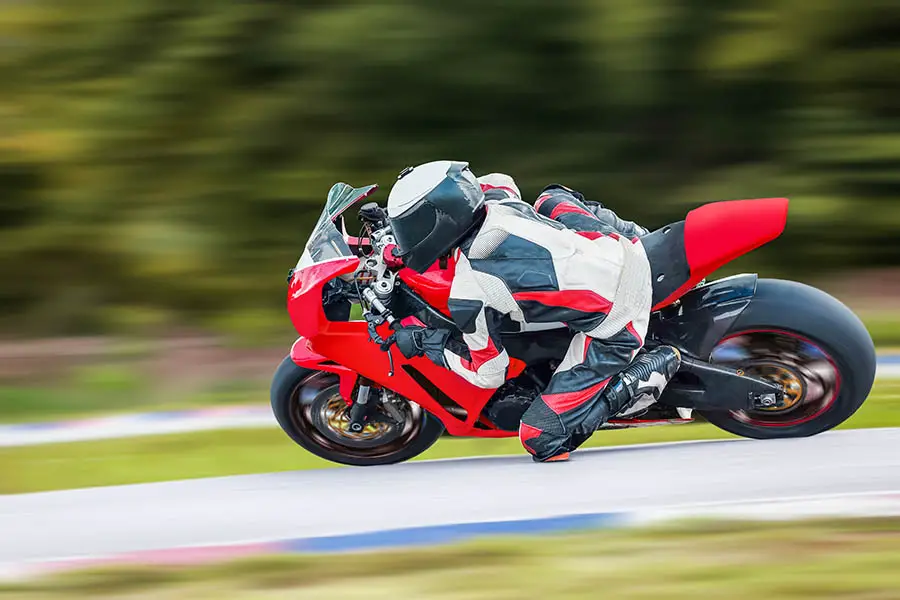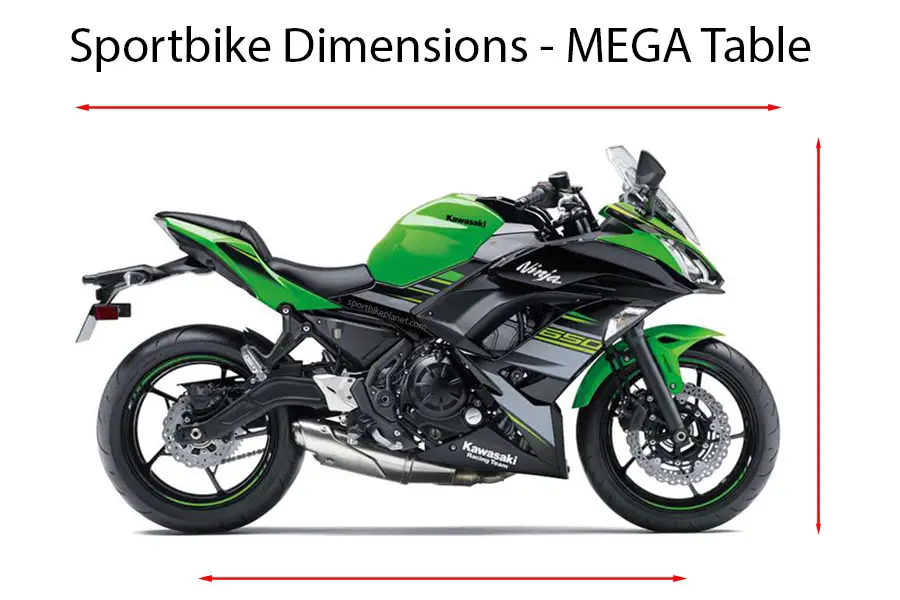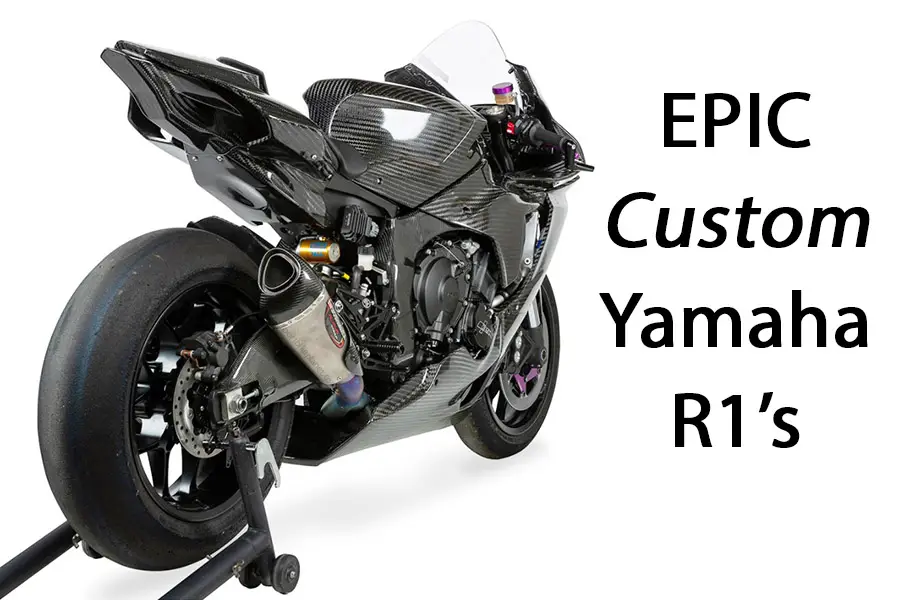Most sportbike tank pads primarily protect your paint, keeping jacket or pants zippers from marring the shiny surface of one of the primary focal points on your machine.
But do they, as some say, actually assist a rider by allowing extra grip between the knees? Is there a consistent benefit for control when attacking the tight twisties?
Possibly.
At the end of the day this is the low down on tank pads:
Motorcycle tank pads are partly for paintwork protection, but can also double as grips to help a rider with hard cornering in a safer manner by allowing better leg grip on the bike. However, the benefit of tank pads for grip are very rider specific.
In short, there is nuance to how “you” may find tank pads…
Do Tank Pads Help With Cornering A Motorcycle?
Everything I know about riding a motorcycle quickly, either intuitively or through a lifetime of studying, practicing, and racing suggests that weight transfer is part and parcel of going fast, changing direction suddenly, and maintaining control.
Certainly, how and when a rider weights the footpegs is one of the primary facets of rider control.
Further, weight transfer forward and aft is vital. If a 180-pound rider scoots around on the seat of a 400-pound motorcycle, the entire balance of the machine shifts along with him.
Front end traction can be enhanced by tucking all the way into the tank. Rear wheel traction can be increased by a rider shifting his weight to the rear of the seat. One would think that keeping that rider compartment open to allow such inputs would be universally desirable.
But a look through the roadracing paddocks of today and days gone by suggests that mileage may vary from racer to racer.

Anecdotal Evidence
Australian born Matt Mladin once dominated the landscape of American superbike racing, winning a record seven championships in a ten-year span between 1999 and 2009. The three times he didn’t win, he finished runner-up in the series. This was in spite of the fact that Mladin, at six feet tall, was a bit big in stature for a top level motorcycle racer.
A crew member from that storied Yoshimura Suzuki era once explained to me that because Matt was unable to get his knees behind the fairing at full tuck, the team had resorted to a sort of “king and queen” seat solution. A raised step towards the rear of the seat served two purposes: The lower forward portion kept Mladin forward and over the front tire through turns, while the higher rear raised his own posterior just enough to allow his knees to tuck out of the wind in the straightaways.
Mladin’s teammate for part of that run was the highly successful in his own right Ben Spies. The more diminutive Ben ran a far different set-up that the boys referred to as the “baby bumper” seat – a thick rubber pad behind him forced him to the rider-forward position that the GSXR handling package best responded to. (Those three second place championship results for the aforementioned Mladin? Yeah, Ben won those years.)
But where do tank pads come into this? Read on…
Current MotoAmerica racer Matthew Scholtz, sitting second in the points in the MotoAmerica series as this is written, is like Mladin a bit lanky for a motorcycle racer. At well over six feet tall, a tuck inside his Westby Racing Yamaha R1 fairing is a challenge.
Scholtz runs a tank extender on his Yamaha, as originally devised by Ed Sullivan at SE Composites. At the time Sullivan, a noted roadracer in his own right and crew chief in the American superbike paddock, ran SE from his home base in Georgia.
Sullivan would later sell the company, but the product is still for sale through a number of aftermarket suppliers. It offers additional support to a rider under braking, reducing weight transfer to the front of the motorcycle (and the rider’s arms) which could also arguably reduce braking performance.

Conversely, however, when multi-time roadracing champion JD Beach struck a deal to ride both MotoAmerica and the American Flat Track series in 2019 with sponsorship from Attack Yamaha and Estenson Yamaha, his results certainly differed.
After Beach first rode one of Attack’s R1 machines in anger, the team was initially stymied by Beach’s complaints of a serious chatter from the front wheel on corner entries – clearly a detriment to both lap times and the rider’s confidence.
The R1 Beach had been testing had been fitted with a tank extension similar to the one used by Scholtz. He asked that it be removed. Now able to nestle right up to the tank when cornering, the chatter disappeared.
And so tank pads… are they relevant in cornering at all?
Positioning On Your Motorcycle For Best Cornering
Rider positioning on the motorcycle clearly matters, but there’s not a one size fits all answer. Technique varies from one bike to another, and from one rider to the next.
I’ve personally always been a bigger fan of being able to move around on the bike unobstructed, to be able to shift my own weight from side to side unencumbered. I’m more concerned with how I’m weighting the footpegs on corner entry than I am with how my knees make contact with anything other than the tarmac.
But some guys – including many that are much quicker than I ever was – do prefer to be more locked into the rider compartment.
Either way, your legs are certainly one of the primary anchor points to your motorcycle. Some racers across the paddock do use some sort of grip tape-like substance at the sides of the tank where the knees meet the surface, saying it increases their control of the motorcycle while riding aggressively in sudden corner transitions.
To me, the only real benefit to a tank pad is cosmetic – to keep from having the paint on my pride and joy scratched up. But if you’re one who ascribes to the locked-into the cockpit philosophy, here’s a few options for additional grip that I could see being an asset to riders like you.
Ultimately, whether tank pads help to grip in the corners is almost entirely up to the style of the rider.
TechSpec Gripsters
TechSpec offers a more functional alternative on the tank pad theme with black synthetic rubber available in three different variations of tread patterns, and in slightly varying thicknesses.
Pre-cut selections are available for many popular sportbikes. The company also sells non-bike specific pads that can be trimmed to fit any motorcycle.
TechSpec’s “Snake Skin” material has a low profile diamond pattern that is .125 inches thick. Their “C3” alternative has a less aggressive pattern, is softer and gummier, and measures .100 inches think. Their thinnest offering is dubbed “High Fusion” and is just .035 thick.

Gripster kits start at about $50 for universal fitment, and are somewhere in the $60-100 range for specific models. The TechSpec website has a dealer locator, and also offers direct to consumer sales.
Stormgrip
Another choice on the market embraced by some racers – like 6-time World Superbike champion Jonathan Rea, for one – is the Stormgrip brand of tank protectors.
Stormgrip products are custom designed injected molded tank mats available in either clear or black, and in four different “traction profiles” – Volcano, Super Volcano, Icon, and Quad Plate.
The Icon pattern is eponymous, using the company’s own logo as a pattern. It is billed as Stormgrip’s least aggressive pattern. The Volcano, which was their original offering, offers considerably more grip with a pattern of protruding divots to allow grip to the rider. As the name implies, the Super Volcano has a roughly the same pattern with even taller and more pointed protrusions.

Stormgrip offers an extensive selection of specific to a given motorcycle installations, as well as universal kits that can be cut to fit if no pattern is available for your bike.
Stormgrip offers direct to consumer sales through their own website, with most kits retailing at $64.99. The products are also available through discount big box outlets like cyclegear.com.
Eazi-Grip tank grips
From the other side of the pond comes the British-based Eazi-Grip tank grips, said to be used by a number of racers in the British Superbike series as well as at the Isle of Man.
Eazi-Grip likewise offers three different compounds, with the “Evo” closely resembling Stormgrip’s Volcano with notably big bumps for maximum grip. The company also has a “Pro” line which is less aggressive to allow somewhat easier movement on the bike. The third selection dubbed “Silicone” has a lightly textured surface that errs on the side of rider comfort over maximum adhesion.
The company offers an extensive selection of bike-specific choices that are specifically cut to each model in either clear or black.

Depending on where you reside, the Eazi-Grip racing products line could be difficult to access. Their website lists only three dealers in the United States!
The company does offer direct to consumer sales through its website, with most products starting at £38.39, or approximately $40 U.S.



